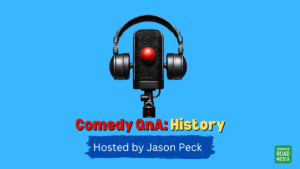I was doing my penultimate speech in an Advanced Manual at my Toastmasters club Grosvenor Square Speakers recently. There were only 16 people in the audience, including the time-keeper and General Evaluator. I was all set to go on second, when my name suddenly got read out to speak first.
I went up and did reasonably well, but not as good as I could’ve done. So what was different this time…?
For a start there were only 16 people in the audience as I said. Whilst that’s absolutely not a problem for generating laughs, it is when they are all spread out. I knew how they should be sat, but I thought that this would be a good time to experiment and try out the theory. And it bore fruit. Whilst there were a few smattering of laughs, it didn’t “catch fire”.
Yes, a full audience of 30 at this particular club would’ve been ideal. But what would’ve helped enormously with the audience that was there was if they were sat closer together, rather than spread out. Laughter begets laughter, it can spread like the flu. But only if the audience are sat closer enough to “infect” other people.
I noticed a similar thing when I did my first speech from the humorously speaking manual earlier in the year. This time I went on after a speaker did a storytelling speech and so the audience were sat side-by-side in a semi-circle. Not the most ideal seating arrangement either, but slightly better.
The second thing which I could’ve done, and which I had prepared to do but got thrown by going on first, was to take my dictaphone on stage with me and record my speech. This is something that I’ve gotten into the habit of doing and only forgotten once or twice.
By having a recording of the speech, either on a dictaphone or video, you would have evidence of where the laughs came during your speech. It’s not always possible to remember which of your punchlines worked and which didn’t. I know because that’s what I tried to do afterwards.
By recording the speech you can work out exactly which punchlines worked and which need re-writing. You can also get to see, or hear, how long each laugh lasted for. This is especially valuable if you’re going to run it through the Comedy Evaluator Pro and get a PAR score. Further information on the software can be found on the C.E.P website.
The Killer Standup System that the Comedy Evalautor Pro comes with is supplied in this review of mine Killer Stand-up review.
Remember when you’re in front of an audience using humour fundamentally there are two things that could be happening:
1) the performer is speaking
2) the audience is responding
The audience response (laughter, cheering, applauding) is referred to as a Positive Audience Responce or PAR. For comedians the following is often true: headliners are getting 4-6 laughs or more per minute with a PAR score of 30 or above. Whereas a speaker who uses humour is aiming for a PAR of 15, or above. According to the software a PAR of 15 is achievable with 9-12 seconds of laughter.
However, it should be noted that my mentor Steve Roye suggests that humorous speakers aim for an overal PAR score of 15 which is 45 seconds of positive audience response for every 5 minutes of performing time.
So next time you have to deliver a speech that uses humour, see if your room is set up correctly with the audience sat close to each other. Make sure that you have a recording device to make sure you can find out where those laughs come and what needs to be worked on.




2 comments
Are you a Bronze now then?
Author
Hi Jeremy,
Nope, not Bronze yet. I’ve got one more speech to go then I’ll have my Advanced Communicator Bronze.